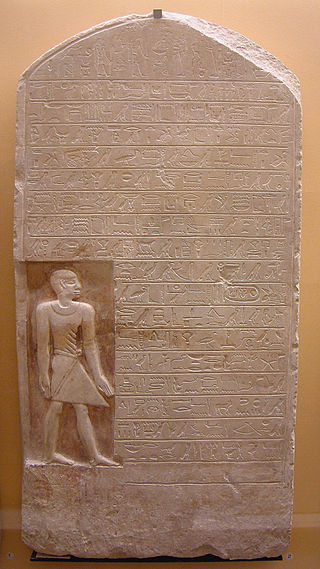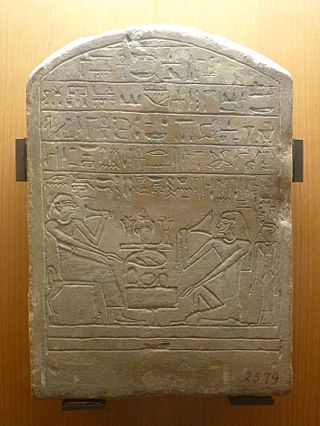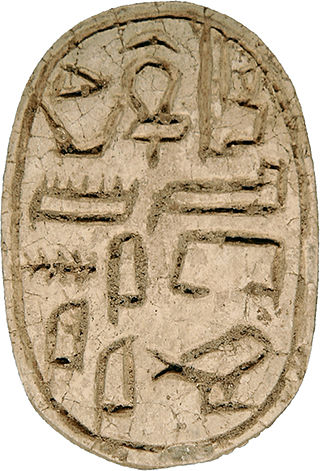Related Research Articles

Amenemhat III, also known as Amenemhet III, was a pharaoh of ancient Egypt and the sixth king of the Twelfth Dynasty of the Middle Kingdom. He was elevated to throne as co-regent by his father Senusret III, with whom he shared the throne as the active king for twenty years. During his reign, Egypt attained its cultural and economic zenith of the Middle Kingdom.

Userkare Khendjer was a minor king of the early Thirteenth Dynasty of Egypt during the Middle Kingdom. Khendjer possibly reigned for four to five years, archaeological attestations show that he was on the throne for at least three or four years three months and five days. Khendjer had a small pyramid built for himself in Saqqara and it is therefore likely that his capital was in Memphis.

Nubkaure Amenemhat II, also known as Amenemhet II, was the third pharaoh of the 12th Dynasty of ancient Egypt. Although he ruled for at least 35 years, his reign is rather obscure, as well as his family relationships.

Senusret I also anglicized as Sesostris I and Senwosret I, was the second pharaoh of the Twelfth Dynasty of Egypt. He ruled from 1971 BC to 1926 BC, and was one of the most powerful kings of this Dynasty. He was the son of Amenemhat I. Senusret I was known by his prenomen, Kheperkare, which means "the Ka of Re is created." He expanded the territory of Egypt allowing him to rule over an age of prosperity.

Khasekhemre Neferhotep I was an Egyptian pharaoh of the mid Thirteenth Dynasty ruling in the second half of the 18th century BC during a time referred to as the late Middle Kingdom or early Second Intermediate Period, depending on the scholar. One of the best attested rulers of the 13th Dynasty, Neferhotep I reigned for 11 years.

Khaneferre Sobekhotep IV was one of the more powerful Egyptian kings of the 13th Dynasty, who reigned at least eight years. His brothers, Neferhotep I and Sihathor, were his predecessors on the throne, the latter having only ruled as coregent for a few months.

Ankhu was an Egyptian vizier during the early 13th Dynasty in the late Middle Kingdom. He is believed to have resided in Thebes in Upper Egypt.

Senebsumai was an ancient Egyptian official of the early 13th Dynasty with the title high steward and later treasurer.

Iymeru Neferkare was the ancient Egyptian vizier under king Sobekhotep IV in the 13th Dynasty, in the Second Intermediate Period.

Aya was an ancient Egyptian king's wife of the early Thirteenth Dynasty.

Senebi was an ancient Egyptian treasurer under the late 13th Dynasty kings Neferhotep I and Sobekhotep IV. Senebi belongs to the best attested officials of the 13th Dynasty.
The Papyrus Boulaq 18 is an ancient Egyptian administrative document. It contains an account of the Theban palace dating to the 13th Dynasty. The papyrus lists the palace officials and the rations they received day by day. Important officials mentioned are, for example, the vizier Ankhu, but also the queen Aya. Therefore, the document is of great historical importance. It also reports the journey of the king to the temple at Medamud and reports the arrival of a delegation of Nubians.

Senewosret-Ankh {s-n-wsrt-ꜥnḫ/snfrw} was an ancient Egyptian vizier of the Middle Kingdom, dating to the end of the Twelfth or to the beginning of the Thirteenth Dynasty.

Ikhernofret was an ancient Egyptian treasurer of the 12th Dynasty, under king Senusret III until the early years of Amenemhat III. On his monuments he bears several important titles, including overseer of the double treasury, overseer of the double gold house, royal sealer and his main title treasurer. Ihkernofret is known from several stelae found at Abydos. One of these stelae contains a biography. This stela is now in the Egyptian Museum of Berlin. According to its text, Ikhernofret grew up at the royal court. When he was 26, he became friend of the king, which was most likely a special honor. However, the text of the stela is of special importance as it reports the arrangement by Ikhernofret of a festival for Osiris at Abydos.

Khahotepre Sobekhotep VI was an Egyptian king of the late 13th Dynasty during the Second Intermediate Period.

Ameny was an ancient Egyptian official of the 13th Dynasty with the title high steward. In this function he was the main administrator of the royal estates.

Nebankh was an ancient Egyptian official of the Thirteenth Dynasty. He is one of the better known personalities of this period.
Hor was an ancient Egyptian official who was in office under Senusret I, around 1950 BC. Hor is known from a number of monuments, most of them found at Abydos, where he most likely had a chapel. He is also known from a stela found in the Wadi el-Hudi. His most important title was high steward. Other titles include overseers of sealers and overseer of the gateway. In the function of high steward, he administered the royal domains. He bore the highest ranked titles, such as Iry-pat or Haty-a. Only one of his monuments is dated. The monument bears the year date 9 of Senusret's I reign, providing evidence that he was in office in the first part of that king's reign.

Aabeni was an ancient Egyptian official with the title high steward. He was one of the most important officials at the royal court in the early Thirteenth Dynasty.
Dedusobek Bebi was a high official of the late Thirteenth Dynasty of ancient Egypt. He became the "Great Scribe of the Vizier". This position was directly under the Vizier acting as a deputy.
References
- 1 2 "Person PD 389". Persons and Names of the Middle Kingdom. Johannes Gutenberg Universität Mainz. Retrieved 30 July 2022.
- ↑ Grajetzki, Wolfram (2001). Two Treasurers of the Late Middle Kingdom. Oxford, England: Archaeopress. pp. 42–44. ISBN 9781841712864.
- ↑ Grajetzki, Wolfram (2013). "Setting A State Anew: The Central Administration from the End of the Old Kingdom to the End of the Middle Kingdom". In Moreno García, Juan Carlos (ed.). Ancient Egyptian Administration. Leiden: Brill. p. 242. ISBN 978-90-04-24952-3 . Retrieved 30 July 2022.
- ↑ "Georges Oyex Basel | Persons and Names of the Middle Kingdom".
- ↑ "Stela, Cairo CG 20147 | Persons and Names of the Middle Kingdom".
- ↑ "Stela, Wadi el-Hudi 24 | Persons and Names of the Middle Kingdom".
- ↑ "Statue, Georges Oyex Basel | Persons and Names of the Middle Kingdom".